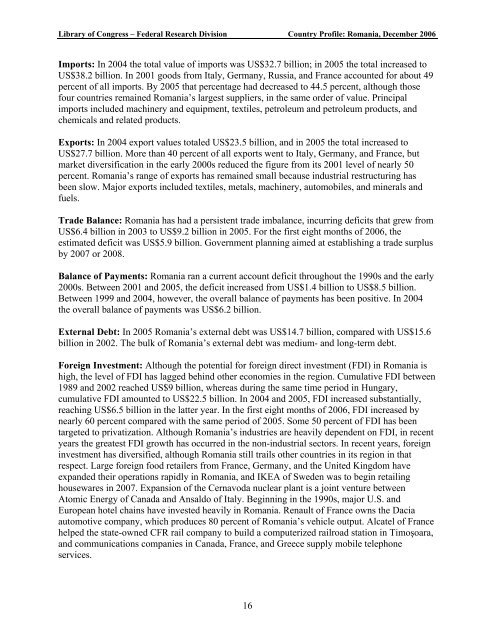Country Profile: Romania - Library of Congress
Country Profile: Romania - Library of Congress
Country Profile: Romania - Library of Congress
Create successful ePaper yourself
Turn your PDF publications into a flip-book with our unique Google optimized e-Paper software.
<strong>Library</strong> <strong>of</strong> <strong>Congress</strong> – Federal Research Division <strong>Country</strong> <strong>Pr<strong>of</strong>ile</strong>: <strong>Romania</strong>, December 2006<br />
Imports: In 2004 the total value <strong>of</strong> imports was US$32.7 billion; in 2005 the total increased to<br />
US$38.2 billion. In 2001 goods from Italy, Germany, Russia, and France accounted for about 49<br />
percent <strong>of</strong> all imports. By 2005 that percentage had decreased to 44.5 percent, although those<br />
four countries remained <strong>Romania</strong>’s largest suppliers, in the same order <strong>of</strong> value. Principal<br />
imports included machinery and equipment, textiles, petroleum and petroleum products, and<br />
chemicals and related products.<br />
Exports: In 2004 export values totaled US$23.5 billion, and in 2005 the total increased to<br />
US$27.7 billion. More than 40 percent <strong>of</strong> all exports went to Italy, Germany, and France, but<br />
market diversification in the early 2000s reduced the figure from its 2001 level <strong>of</strong> nearly 50<br />
percent. <strong>Romania</strong>’s range <strong>of</strong> exports has remained small because industrial restructuring has<br />
been slow. Major exports included textiles, metals, machinery, automobiles, and minerals and<br />
fuels.<br />
Trade Balance: <strong>Romania</strong> has had a persistent trade imbalance, incurring deficits that grew from<br />
US$6.4 billion in 2003 to US$9.2 billion in 2005. For the first eight months <strong>of</strong> 2006, the<br />
estimated deficit was US$5.9 billion. Government planning aimed at establishing a trade surplus<br />
by 2007 or 2008.<br />
Balance <strong>of</strong> Payments: <strong>Romania</strong> ran a current account deficit throughout the 1990s and the early<br />
2000s. Between 2001 and 2005, the deficit increased from US$1.4 billion to US$8.5 billion.<br />
Between 1999 and 2004, however, the overall balance <strong>of</strong> payments has been positive. In 2004<br />
the overall balance <strong>of</strong> payments was US$6.2 billion.<br />
External Debt: In 2005 <strong>Romania</strong>’s external debt was US$14.7 billion, compared with US$15.6<br />
billion in 2002. The bulk <strong>of</strong> <strong>Romania</strong>’s external debt was medium- and long-term debt.<br />
Foreign Investment: Although the potential for foreign direct investment (FDI) in <strong>Romania</strong> is<br />
high, the level <strong>of</strong> FDI has lagged behind other economies in the region. Cumulative FDI between<br />
1989 and 2002 reached US$9 billion, whereas during the same time period in Hungary,<br />
cumulative FDI amounted to US$22.5 billion. In 2004 and 2005, FDI increased substantially,<br />
reaching US$6.5 billion in the latter year. In the first eight months <strong>of</strong> 2006, FDI increased by<br />
nearly 60 percent compared with the same period <strong>of</strong> 2005. Some 50 percent <strong>of</strong> FDI has been<br />
targeted to privatization. Although <strong>Romania</strong>’s industries are heavily dependent on FDI, in recent<br />
years the greatest FDI growth has occurred in the non-industrial sectors. In recent years, foreign<br />
investment has diversified, although <strong>Romania</strong> still trails other countries in its region in that<br />
respect. Large foreign food retailers from France, Germany, and the United Kingdom have<br />
expanded their operations rapidly in <strong>Romania</strong>, and IKEA <strong>of</strong> Sweden was to begin retailing<br />
housewares in 2007. Expansion <strong>of</strong> the Cernavoda nuclear plant is a joint venture between<br />
Atomic Energy <strong>of</strong> Canada and Ansaldo <strong>of</strong> Italy. Beginning in the 1990s, major U.S. and<br />
European hotel chains have invested heavily in <strong>Romania</strong>. Renault <strong>of</strong> France owns the Dacia<br />
automotive company, which produces 80 percent <strong>of</strong> <strong>Romania</strong>’s vehicle output. Alcatel <strong>of</strong> France<br />
helped the state-owned CFR rail company to build a computerized railroad station in Timoşoara,<br />
and communications companies in Canada, France, and Greece supply mobile telephone<br />
services.<br />
16

















